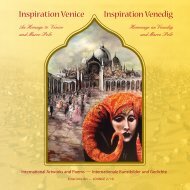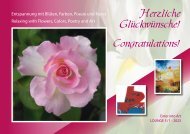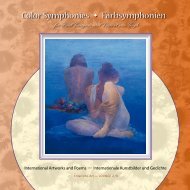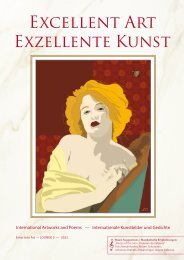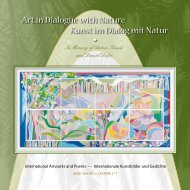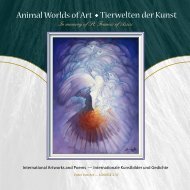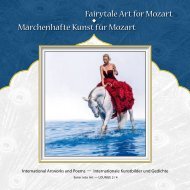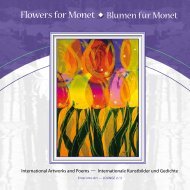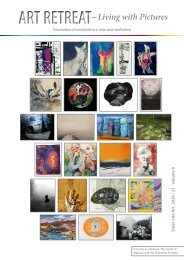Moonlight Sonatas - Mondscheinsonaten - for Beethoven
Name a tune you want to listen to again and again, because it goes straight to the heart. Millions on the internet click “Moonlight Sonata” in response to this call. At the occasion of Beethoven’s 250th birthday and - with boundless sensitivity - 69 artists from 26 countries got together and interpreted the “Moonlight Sonata” in visual terms. Was it not the image of a landscape, after all, that led to the work’s famous epithet? In a way, listening to the sonata resembles looking at a landscape painting by Caspar David Friedrich or William Turner, and losing oneself in the rapt observation of the distant satellite. The editor of this art-inspired almanac has divided the artists’ visual ideas into different chapters, and accentuated them with selected haiku poetry, exquisite quotes, art-inspired slogans and illustrations. The result is a multifaceted homage. The printed book is available in the book trade and in internet bookshops. Softcover: ISBN 978-3-98527-148-1, Publisher: Re Di Roma-Verlag, Language: English, German, Size: 21 x 21 cm Or at Peecho (soft- and hardcover) by the following link: https://www.peecho.com/checkout/161866719083658635/1008226/moonlight-sonatas-for-beethoven-mondscheinsonaten Ein Musikstück, das man immer wieder hören will, weil es unmittelbar ins Herz trifft? Millionen von Klicks im Internet beantworten diese Frage mit „Mondscheinsonate“. Anlässlich des 250. Geburtstages von Ludwig van Beethoven fanden sich 69 Künstler aus 26 Ländern zusammen, um die „Mondscheinsonate“ in bildhafter Weise und mit grenzenloser Einfühlungsgabe zu interpretieren. War es nicht auch das Bild einer Landschaft, welches ihr den berühmten Beinamen gab? Man kann die Sonate hören und wie in einer Landschaftsszenerie von Caspar David Friedrich oder William Turner in der andächtigen Betrachtung des fernen Trabanten versinken. Der Herausgeber dieses kunstbeseelten Almanachs hat die bildlichen Gedanken der Künstler in verschiedene Kapitel aufgeteilt und durch ausgewählte Haiku-Lyrik, erlesene Zitate, sowie kunstästhetische Slogans und Illustrationen untermalt. Dadurch wurde eine vielseitige Hommage geschaffen.
Name a tune you want to listen to again and again, because it goes straight to the heart. Millions on the internet click “Moonlight Sonata” in response to this call. At the occasion of Beethoven’s 250th birthday and - with boundless sensitivity - 69 artists from 26 countries got together and interpreted the “Moonlight Sonata” in visual terms. Was it not the image of a landscape, after all, that led to the work’s famous epithet? In a way, listening to the sonata resembles looking at a landscape painting by Caspar David Friedrich or William Turner, and losing oneself in the rapt observation of the distant satellite. The editor of this art-inspired almanac has divided the artists’ visual ideas into different chapters, and accentuated them with selected haiku poetry, exquisite quotes, art-inspired slogans and illustrations. The result is a multifaceted homage.
The printed book is available in the book trade and in internet bookshops. Softcover: ISBN 978-3-98527-148-1, Publisher: Re Di Roma-Verlag, Language: English, German, Size: 21 x 21 cm
Or at Peecho (soft- and hardcover) by the following link:
https://www.peecho.com/checkout/161866719083658635/1008226/moonlight-sonatas-for-beethoven-mondscheinsonaten
Ein Musikstück, das man immer wieder hören will, weil es unmittelbar ins Herz trifft? Millionen von Klicks im Internet beantworten diese Frage mit „Mondscheinsonate“. Anlässlich des 250. Geburtstages von Ludwig van Beethoven fanden sich 69 Künstler aus 26 Ländern zusammen, um die „Mondscheinsonate“ in bildhafter Weise und mit grenzenloser Einfühlungsgabe zu interpretieren. War es nicht auch das Bild einer Landschaft, welches ihr den berühmten Beinamen gab? Man kann die Sonate hören und wie in einer Landschaftsszenerie von Caspar David Friedrich oder William Turner in der andächtigen Betrachtung des fernen Trabanten versinken. Der Herausgeber dieses kunstbeseelten Almanachs hat die bildlichen Gedanken der Künstler in verschiedene Kapitel aufgeteilt und durch ausgewählte Haiku-Lyrik, erlesene Zitate, sowie kunstästhetische Slogans und Illustrationen untermalt. Dadurch wurde eine vielseitige Hommage geschaffen.
You also want an ePaper? Increase the reach of your titles
YUMPU automatically turns print PDFs into web optimized ePapers that Google loves.
In spite of its overall musical perfection, it is<br />
usually the first movement of the world famous<br />
“<strong>Moonlight</strong> Sonata” that magically attracts people.<br />
<strong>Beethoven</strong> called his three-part work a “Sonata<br />
quasi una Fantasia”, and famously remarked about<br />
his Piano Sonata No. 14 in C-sharp minor, Op. 27,<br />
No. 2: “Surely, I’ve written better things.” Taking liberties<br />
on the classical sonata <strong>for</strong>m, and displaying<br />
new emotional depths, the work is seen as a significant<br />
precursor of Romantic music. The dreamy<br />
Adagio in the first movement has been engraved<br />
in many people’s memory. The familiar sound of<br />
the tune is wont to suddenly appear from the depth<br />
of our mind, while we may be looking at the moon<br />
and, possibly inspired by Caspar David Friedrich’s<br />
paintings, lose ourselves in the magic of the scenery.<br />
When the poet Ludwig Rellstab listened to it, he<br />
felt reminded of a nocturnal boat trip, making him<br />
coin the name “<strong>Moonlight</strong> Sonata” in 1823. Franz<br />
Liszt likened its short second movement to “a flower<br />
between two abysses”. In the third movement,<br />
finally, the music storms towards a merciless, desperate<br />
finale.<br />
<strong>Beethoven</strong> wrote the „<strong>Moonlight</strong> Sonata“ in<br />
1801, probably in the gardener’s cottage at Unterkrupka<br />
Castle in what is now Slowakia. This is the<br />
reason the work originally became known as the<br />
“Summer House Sonata”. While staying at the cottage,<br />
the nature-loving composer’s heart may well<br />
have felt captivated by the aesthetic dimension of<br />
the nocturnal visual stimuli surrounding him. Like<br />
a landscape or a moonlight sketch, the tonal sensitivity<br />
of the “<strong>Moonlight</strong> Sonata” allows a mood<br />
of nature to speak <strong>for</strong> itself. Similarly, the truth of<br />
a painting lies not so much in the superficial depiction<br />
of a phenomenon, as in the abstracting <strong>for</strong>ce<br />
of its spiritual message. The surrealist painter Max<br />
Ernst, <strong>for</strong> example, a great admirer of Caspar David<br />
Friedrich, gifted a painting of the moon to his wife<br />
Dorothea Tanning <strong>for</strong> her birthday every year, as a<br />
declaration of his love <strong>for</strong> her.<br />
The history of the Sonata resembles a jigsaw<br />
puzzle. On the one hand, it seems to convey the<br />
effective course of light in a dramatically beautiful<br />
cloudy sky, and a close observation of atmospheric<br />
components, on the other, it is remindful of a dark<br />
monochromaticity. At the same time, the vibrato of<br />
its energetic musical notation captures the ephemeral<br />
nature of a rapidly changing mood. Between<br />
1800 and 1806, <strong>Beethoven</strong> did not only spend time<br />
in Unterkrupka, but also frequently stayed at the<br />
Brunsvik family’s Hungarian castle Martonvásár.<br />
Both castles are surrounded by spacious parks<br />
landscaped in the style of English gardens. Here,<br />
<strong>Beethoven</strong> was able to leave behind his busy life in<br />
Vienna, and relax. Presumably, this was the time he<br />
met the love of his life, but it was also the time he<br />
first realized that he was losing his hearing. In 1802,<br />
he wrote the famous „Heiligenstadt Testament“.<br />
The gloomy aspect of the Sonata, however,<br />
tends to be perceived mostly by musical virtuosos,<br />
owed to their perceptive depth. <strong>Beethoven</strong><br />
was interested in philosophy and literature, while<br />
struggling with politics. As he was beginning to feel<br />
the effects of his deafness, thoughts about death<br />
cannot be ruled out while he was composing the<br />
Sonata. Helplessly, he had to stand by and endure<br />
no longer being able to listen to his own music,<br />
or the sound of birdsong that he loved so much.<br />
Passionately, he went <strong>for</strong> walks and observed the<br />
scenery, while rejoicing in the voices of nature. His<br />
creativity was also reflected in his interest <strong>for</strong> exotic<br />
instruments. While composing the Sonata, he was<br />
especially interested in the aeolian harp. And indeed,<br />
the inner harmony of the adagio resembles the<br />
sound of a harp, the distant whisper of the wind,<br />
or a muted murmur, while the bright trilling outer<br />
voice sets the tempo. <strong>Beethoven</strong> indicated to play<br />
the tune with extreme tenderness. The particular<br />
appeal of the aeolian harp is that it can trans<strong>for</strong>m<br />
the sounds of nature into a kind of vocal canon,<br />
which may have inspired the melancholy part of<br />
the “<strong>Moonlight</strong> Sonata” and, together with its light<br />
piano chords, may embody the moon rising from<br />
the darkness.<br />
It is hardly surprising that the „<strong>Moonlight</strong> Sonata“<br />
was already popular during <strong>Beethoven</strong>‘s<br />
lifetime. The moon is as old as the earth, and female<br />
in many languages. It was not its physical<br />
existence, however, but the picturesque appeal of<br />
its appearance, and the eruptive power of the full<br />
moon that, in a sense, were reflected in <strong>Beethoven</strong>’s<br />
personality. In Shakespeare’s “Othello”, the moon<br />
kills and drives people mad. Yet lovers of all times<br />
have succumbed to its magic. In the year after it<br />
was written, <strong>Beethoven</strong> dedicated the Sonata to his<br />
then 20-year-old piano student, the Countess Julie<br />
Guicciardi. But had he really written it <strong>for</strong> her? There<br />
was also Josephine, another woman whom, due to<br />
the misguided social constraints of his time, <strong>Beethoven</strong><br />
could not have. As a trusted sister and freespirited<br />
educator, Therese later found the perfect<br />
words to describe their situation: “They were made<br />
<strong>for</strong> each other, and if both of them were still alive,<br />
Photo collage: Homage to the Moon<br />
11




